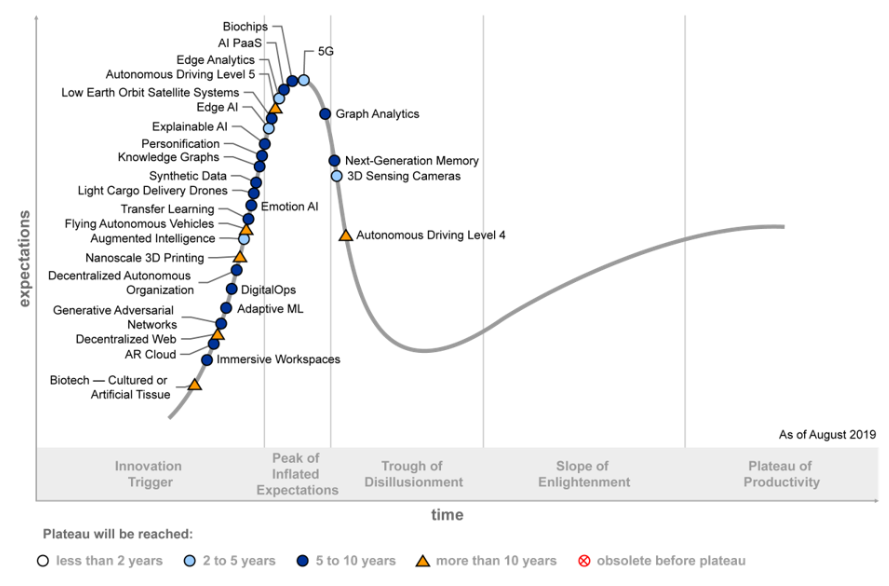Five emerging technologies with transformational impact - Gartner
By Staff Writer 30 August 2019 | Categories: news (1).jpg)
Want to know what new tech will have the biggest impact over the next few years? The 29 must-watch technologies on IT research company, Gartner’s Hype Cycle for Emerging Technologies, 2019 revealed five distinct emerging technology trends that create and enable new experiences. These leverage artificial intelligence (AI) and other constructs to enable organisations to take advantage of emerging digital ecosystems.
The Hype Cycle for Emerging Technologies is unique among most Gartner Hype Cycles because it garners insights from more than 2000 technologies into a succinct set of 29 emerging technologies and trends. This Hype Cycle specifically focuses on the set of technologies that show promise in delivering a high degree of competitive advantage over the next five to 10 years (see Figure 1).
Figure 1. Hype Cycle for Emerging Technologies, 2019

Five Emerging Technology Trends
Sensing and Mobility
By combining sensor technologies with AI, machines are gaining a better understanding of the world around them, enabling mobility and manipulation of objects. Sensing technologies are a core component of the Internet of Things (IoT) and the vast amounts of data collected. Utilising intelligence enables the ability to gain many types of insights that can be applied to many scenarios.
For example, Gartner notes over the next decade AR cloud will create a 3D map of the world, enabling new interaction models and in turn new business models that will monetise physical space.
Organisations that are seeking leverage sensing and mobility capabilities should consider the following technologies: 3D-sensing cameras, AR cloud, light-cargo delivery drones, flying autonomous vehicles and autonomous driving Levels 4 and 5.
Augmented Human
Augmented human advances enable the creation of cognitive and physical improvements as an integral part of the human body. An example of this is the ability to provide superhuman capabilities such as the creation of limb prosthetics with characteristics that can exceed the highest natural human performance.
Emerging technologies focused on extending humans includes biochips, personification, augmented intelligence, emotion AI, immersive workspaces and biotech (cultured or artificial tissue).
Postclassical Compute and Comms
For decades, classical core computing, communication and integration technologies have made significant advances largely through improvements in traditional architectures - faster CPUs, denser memory and increasing throughput as predicted by Moore’s Law. Gartner states the next generations of these technologies adopt entirely new architectures. This category includes not only entirely new approaches, but also incremental improvements that have potentially dramatic impacts.
For example, low earth orbit (LEO) satellites can provide low latency internet connectivity globally. These constellations of small satellites will enable connectivity for the 48% of homes that are currently not connected, providing new opportunities for economic growth for unserved countries and regions. “With only a few satellites launched, the technology is still in its infancy, but over the next few years it has the potential for a dramatic social and commercial impact,” said Brian Burke, research vice president at Gartner.
Enterprises should evaluate technologies such as 5G, next-generation memory, LEO systems and nanoscale 3D printing.
Digital Ecosystems
Digital ecosystems leverage an interdependent group of actors (enterprises, people and things) sharing digital platforms to achieve a mutually beneficial purpose. Digitalisation has facilitated the deconstruction of classical value chains, leading to stronger, more flexible and resilient webs of value delivery that are constantly morphing to create new improved products and services.
Critical technologies to be considered include: DigitalOps, knowledge graphs, synthetic data, decentralised web and decentralised autonomous organisations.
Advanced AI and Analytics
Advanced analytics comprises the autonomous or semiautonomous examination of data or content using sophisticated techniques and tools, typically beyond those of traditional business intelligence (BI).
“The adoption of edge AI is increasing for applications that are latency-sensitive (e.g., autonomous navigation), subject to network interruptions (e.g., remote monitoring, natural language processing [NLP], facial recognition) and/or are data-intensive (e.g., video analytics),” said Burke.
The technologies to track include adaptive machine learning (ML), edge AI, edge analytics, explainable AI, AI platform as a service (PaaS), transfer learning, generative adversarial networks and graph analytics.
This year, Gartner refocused the Hype Cycle for Emerging Technologies to shift toward introducing new technologies that have not been previously highlighted in past iterations of this Hype Cycle. While this necessitates retiring most of the technologies that were highlighted in the 2018 version, it does not mean that those technologies have ceased to be important.
Most Read Articles

Have Your Say
What new tech or developments are you most anticipating this year?



